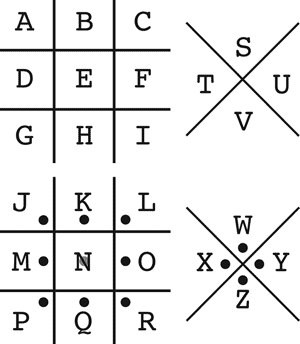The arts of cryptography and deciphering have long been romanticized as an intellectual pursuit akin to a labyrinthine dance of wits. Imagine, for a moment, the exuberance of unraveling an intricate tapestry, thread by thread, each strand imbued with secrets awaiting revelation. Simple ciphers, though beguilingly straightforward, often conceal layers of complexity, inviting the keen-minded to dive deeper into the realm of clandestine communication. In this exploration, we shall illuminate the pathway to breaking a simple cipher without the elusive key, invoking both the simplicity and allure of these cryptographic conundrums.
At the heart of this quandary lies the fundamental understanding of what a cipher entails. A cipher transforms readable data, rendering it into an inscrutable format. One might liken it to a lock—an object endowed with the sole purpose of safeguarding its contents. However, not all locks are crafted with the same precision; some yield to skillful hands, while others remain stubbornly closed. Thus, we begin our journey by identifying the type of cipher at hand. Common examples include substitution ciphers, where letters are interchanged or shuffled, and transposition ciphers, which rearrange the order of characters.
To embark on the art of deciphering, recognizing the characteristics of the cipher becomes imperative. Take, for instance, the Caesar cipher—a whimsical homage to Julius Caesar himself. When faced with such a cipher, one might find solace in the predictable methodology utilized to encrypt messages: a uniform shift of letters across the alphabet. Knowledge of this fixed transposition allows for ruthless experimentation, a simple matter of adjusting the shift until coherence emerges from the chaos. Undoubtedly, a trial-and-error method enveloped in anticipation compels one to unravel the encoded message.
Employing frequency analysis proves indispensable in the endeavor to dismantle more complex substitution ciphers. This technique hinges on the recognition that certain letters in any given language manifest with greater regularity. In English, for example, the letter ‘E’ reigns supreme, followed closely by ‘T’, ‘A’, and ‘O’. Armed with this knowledge, one can engage in a meticulous examination of the encoded message, counting the frequency of each character. Patterns will begin to emerge, akin to a constellation revealing itself in the night’s embroidery of stars. What begins as a jumble transcends into discernible fragments, hinting at the unearthing of the true text.
While frequency analysis provides a robust framework for deciphering, other methodologies complement this approach. Consider their utility in tandem, creating a multifaceted strategy that deepens understanding. The use of common digraphs and trigraphs further enhances this analysis. In the English language, certain combinations of letters appear with heightened frequency—’TH’, ‘HE’, ‘IN’, and ‘ER’, to name a few. By identifying these pairs or triplets, one can more easily decode the ciphertext. It is akin to unraveling a vine, each leaf unveiling a new layer of complexity yielding to the deft touch of the investigator.
Transposition ciphers require a divergent yet equally methodical approach. Herein lies a tangible exercise in spatial manipulation. Writers have often portrayed codes as locked boxes, but with transposition, the contents remain the same, albeit in a novel arrangement. The essence of the message is reconfigured, urgency in preservation interspersed with intrigue. The first step in breaking such ciphers is recognizing identifiable patterns in the ordering of letters. Armed with a grid approach, one can chart letters into rows and columns, teasing order from disorder. This tactile interaction with the cipher serves to deepen one’s understanding of the underlying structure.
However, the most potent weapon in any cryptanalyst’s arsenal is intuition—a cultivated sensibility honed through experience and exposure to the arts of deception. Sometimes, quiet reflection and contemplation can yield the most illuminating insights. One might find it useful to contemplate the sentiment behind the encoded message; understanding the context can facilitate breakthroughs that mere computational analysis cannot. After all, language is imbued with emotion, and interpreting its hidden nuances can lead to triumphant revelations.
Another vital aspect of this cryptographic expedition is the understanding of redundancy in language. Since most languages do not utilize every letter with equal vigor, messages can be organized to exploit this redundancy. This permits educated guesses and educated leaps toward the solution. For instance, if one discerns that a particular letter appears frequently, a logical supposition would be to hypothesize that it might represent a commonly-used letter, such as ‘E’. This iterative process of deduction breathes life into the hunt, each guess a question posed to the cipher, each success a step closer to clarity.
As the process unfolds, the savant will notice how the experimentation leads to a gradual revelation, akin to the sun rising steadily over the horizon, exposing a landscape formerly obscured by the veils of night. Ultimately, the satisfaction derived from breaking a simple cipher lies not merely in the acquisition of knowledge, but in the journey itself—the confluence of logic, creativity, and perseverance that illuminates the intricate world of cryptography.
The task of breaking ciphers—especially simple ones—reveals the nexus between logic and language, a delicate interplay that echo the human quest for meaning and understanding. In this mechanical ballet of symbols, the cryptanalyst hones their craft, refining techniques and sharpening intuition. The fruits of this labor become not just mere information, but conduits through which the silent whispers of history and communication echo across time, waiting to be discovered.
As one delves into this enigmatic underworld, an unwavering sense of curiosity propels the seeker forward, each uncovered secret solidifying the bond between scholar and cipher. The final embrace of clarity, when the code yields to intellect and diligence, marks a moment of triumph, a testament to the human spirit’s resolve to decipher, understand, and, ultimately, communicate.









Leave a Comment